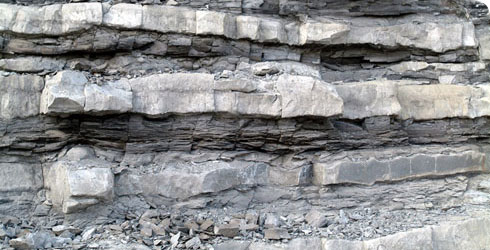Dating methods
Finding out the age of rocks and fossils is important because it helps scientists discover when different species lived on Earth.
There are many different dating methods. Learn about 2 common approaches and how scientists try to ensure accuracy.
Relative dating
Rocks and sediments are deposited on the earth in layers. Unless the earth has been badly disturbed, for example by an earthquake, then the oldest layers of rock will be at the bottom and the newest will be at the top.
By looking at the layers we can find out what order they were deposited in, although we still do not know exactly how old the rocks are. This method is called relative dating.
Fossils can also give scientists important clues to the ages of rocks. Species change through time and they can be used to order the deposits they are found in. Many common fossils have been independently dated by scientists. If one of those fossils is found in a patch of rock then this will help determine how old that rock is.
Fossils that are characteristic of a particular period in geological time, with a precise distribution within the rock record, are known as zone fossils.
For example, various species of ammonite, extinct marine animals related to living squid, are useful zone fossils. They are easily recognisable, abundant and widely geographically distributed, as well as only having existed for relatively short periods of time.
Absolute dating
Absolute dating not only tells us which sediments were deposited first, it also tells us their exact age.
For rocks that are relatively young, the best way of finding this out is to use carbon dating.
There are 3 different types of carbon atoms. All of them are found in rocks, plants, animals and other living things. For carbon dating, 2 forms of carbon are important: Carbon-12 and a heavier atom known as Carbon-14, which is radioactive.
After an organism dies, the proportion of Carbon-14 atoms begins to decrease. 5,730 years later, the proportion of Carbon-14 has halved. By studying the proportion of Carbon-14 atoms, compared to the other carbon atoms, we can find out how old rocks and fossils are.
Problems with dating
Carbon dating is often the most accurate way of finding out the age of a recent fossil and the rock or other deposit it was found in. However, in old fossils, the proportion of Carbon-14 is so low that it is difficult or impossible to date them accurately.
Carbon dating is not generally reliable for finds that are more than 40,000 years old, so other dating methods have to be used.
Scientists try to avoid using a single sample of material to work out its age. Where possible, it is better to take several samples from the same layer and date them all, preferably using different dating methods, to get the most accurate result.
Toolbox

Until 1938 whale carcasses were buried in the Museum grounds so that their flesh would decay leaving only the skeletons.
